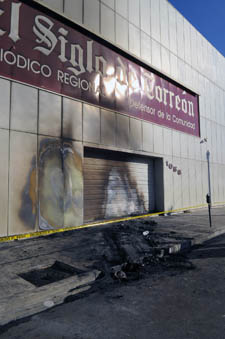It was 3 o’clock in the morning on Tuesday, November 15, 2011, when a car stopped in front of the offices of El Siglo de Torreón, the most widely read newspaper in the northern Mexican states of Coahuila and Durango. The driver pulled the vehicle onto the shoulder, stepped out, poured gasoline on it, and lit it on fire. From another car, AK-47 shots were fired at a window in the newspaper’s offices across the street.
The attack lasted less than five minutes, enough time to complete the job without disturbance. Fortunately, the doors were locked and the staffers who remained inside were in the printing room, protected from the assault. We never found out who torched the car or shot at the windows. That November 15, we received calls from all types of authorities as well as promises of a thorough investigation that never happened.
This did not surprise us or many others in Mexico, where impunity is rampant. Two years before, in August 2009, the paper suffered a similar attack when two individuals fired bullets from machine guns at its front doors. There were no fatalities in that incident either, but the message was clear: Someone was trying to intimidate the paper. Deteriorating security in Torreón, which has become a battleground for cartels and drug traffickers, was a good indication of who could be behind the assaults. But the identity of the attackers remains protected by a shroud of anonymity.
• CPJ’s 2012
Impunity Index
It became clear to us that the impunity with which the first attack was carried out was one of the causes for the second. It’s not because the perpetrators were not the same people, although we will never know for sure. Rather, it was the lack of action by authorities to investigate, pursue, and punish the first attackers that became the seed for the next assault. Our assailants knew nothing would happen to them.
Impunity is the engine that moves attacks on the press and the violence that has torn Mexico apart in recent years.
The attacks against El Siglo de Torreón are but two in a long list of assaults on the Mexican press over the last five years. Estimated to be in the hundreds, they include kidnappings and murders of journalists, threats against reporters and editors, and attacks on media facilities. Pledges to investigate are made in abundance by authorities, but this empty discourse, common in the face of violent attacks, has never become a reality. The concern that authorities express about attacks on the media is not reflected in their actions.
Motives for attacking the press are different, as are the assailants. Most of the intimidation comes from within the political system: government officials trying to suppress incriminating information about them. These are the most common attacks, but not the most vicious. The worst violence comes from organized crime groups looking to either silence stories that could disrupt their operations, or frame and bring attention to their rivals.
In the case of El Siglo de Torreón, the attacks have been linked to organized crime. For a lack of official investigations, we have decided to implement our own security measures.
On the one hand, we have physical security with protective measures for company buildings and reporters on the crime beat, who are given tips on how to act at a crime scene. On the other hand, we have developed “editorial security” guidelines for writing, editing, and the overall presentation of criminal news. Headings and photos are edited in order to avoid magnifying a specific issue. We use a similar approach when describing violent events, trying to avoid giving the impression that we give more coverage to one cartel than to its rival.
Some call it self-censorship, but to us it’s just survival. In the end, the article is published, and the company and its personnel protected.
And then, there is one last issue to keep in mind: Oftentimes, criminals use their crimes to send a message. Decapitating a body is much flashier than shooting someone to death. Mutilation draws even more attention.
That is a dangerous game for the press to play when criminals are trying to impose their agenda on them. Mexico’s unrestrained violence has journalists in the crossfire, a place that we have been dragged to by the impunity that prevails in this country.
